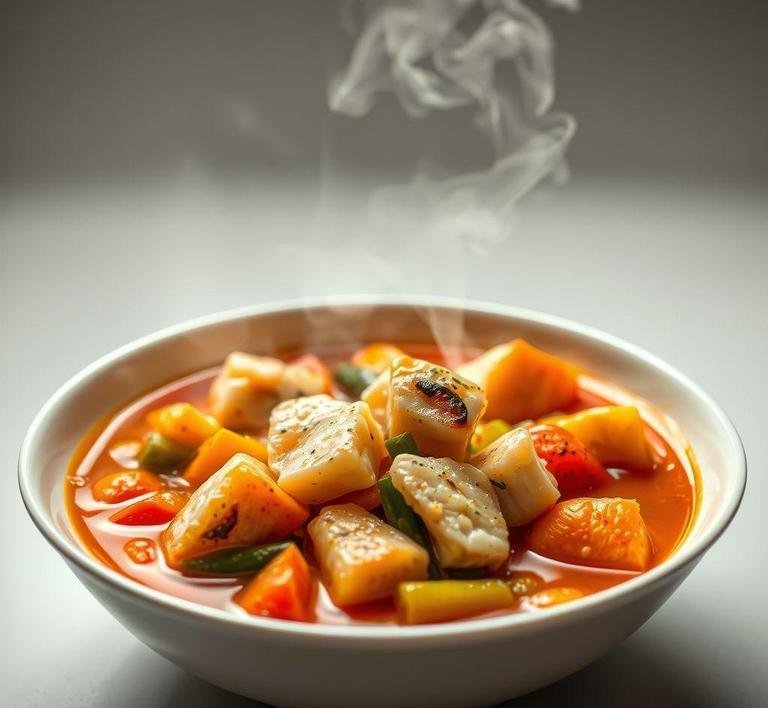Let me take you back to a cold winter night in late January. I had just returned from a windswept walk along the coast, scarf soaked with salt spray and fingers curled into fists inside my gloves. My mood? Somewhere between "do not talk to me" and "maybe I’ll just eat cereal for dinner." That’s when I remembered Nigella’s fish stew.
Now, I’ve cooked a lot of stews in my time-beefy ones that feel like a hug, lentil ones that seem vaguely virtuous. but there’s something about Nigella’s fish stew that sits in its own elegant corner. It’s not showy or complex. It doesn’t demand stock simmered for 24 hours or 12 different types of seafood. It’s honest. It’s warming. And it feels like someone just took your day in their hands and told it, ’Enough. Let me make this better.’
Nigella’s fish stew is her answer to a Mediterranean daydream: tomato-rich, spiked with garlic, heavy on the olive oil and finished with tender chunks of white fish that flake at the touch of a spoon. It’s one of those meals that tastes like it’s been passed down from a coastal grandmother who believes in afternoon naps and always insists on second helpings.
Nigella Fish Stew Recipe
Ingredients Needed

Here’s what you’ll need but let’s not just rattle off a shopping list. each item here plays its own little symphony.
- Olive oil – And not the shy kind. You want it fruity and generous. This is the soul of the stew.
- Garlic (3-4 cloves) – Sliced, not crushed. Let it perfume the oil like a whispered secret.
- Onion (1 large, finely chopped). The aromatic base. Think of it as the foundation of your little edible house.
- Celery (2 stalks, finely diced). Don’t skip it. It disappears into the stew, yes but it gives a backbone of earthiness.
- Carrot (1 large, peeled and diced). For sweetness and that rustic orange glow.
- Fennel bulb (optional but please do it). Brings in that aniseed flirtation and the smell while it’s cooking? Magic.
- Chili flakes (a pinch or two if you need the comfort of heat). Life is too short for bland stews.
- Canned chopped tomatoes (1 x 400g tin). Go for the good kind. This is not the time for watery tomatoes that taste like nothing.
- White wine (about 150ml). A splash for the stew, a splash for the cook. It lifts everything.
- Fish stock or water (500ml). Homemade if you’ve got it but don’t stress. I once made it with plain water and no one died.
- Firm white fish (like cod, haddock or halibut – about 500g) – Cut into generous chunks. They should feel luxurious.
- Fresh parsley (a small handful, chopped). It’s like the punctuation mark at the end of a perfect sentence.
- Salt and pepper – Taste as you go and taste again.
Optional:
- A handful of peeled prawns or mussels. Only if you’re feeling fancy.
- Crusty bread – Not optional in this house.
Equipment Needed
Keep it simple. No need to drag out the stand mixer.
- A heavy-bottomed saucepan or Dutch oven. Something that retains heat and simmers without drama.
- A wooden spoon – Preferably one stained from a hundred past stews.
- A cutting board and knife – Sharp. Dull knives are kitchen villains.
- A ladle – Trust me, ladling stew is a tiny ritual of its own.
Instructions To Make Nigella Lawson’s Fish Stew
- Warm the oil in your pot and gently sauté the garlic, onion, celery, carrot and fennel if you’re using it. Don’t rush this. Let the veg sweat and soften. Put on music-maybe something Italian or nostalgic. Stir occasionally. Sip your wine.
- Add chili flakes and give it all a stir. Then in goes the white wine. Let it bubble up and reduce slightly. this is where the alchemy starts.
- Pour in the chopped tomatoes and stock, bring it to a gentle boil, then reduce to a simmer. Let it murmur away for 15-20 minutes, just enough for all the flavors to make friends.
- Now, in with the fish. Lay it gently in the broth, cover the pot and let it poach for 5-8 minutes. Don’t stir too much or the fish will break into sad little flakes.
- If you’re adding prawns or mussels, tuck them in now and cook until they’re just done. The prawns should turn pink and plump, the mussels should open like tiny yawns.
- Taste. Season. Taste again. This part is intimate. You’re deciding what this stew says.
- Scatter with fresh parsley, grab a hunk of crusty bread and call it dinner.
What I Learnt
This stew taught me that you don’t need complexity for comfort. I’ve cooked it for friends who were going through heartbreak, for myself when the world felt like too much and even once for my mother-who, despite being raised on hearty Yorkshire fare, declared it “bloody perfect”.
I also learned how to trust timing. Fish cooks quickly and the temptation to fuss over it is real. But this recipe taught me to back off a little, to let things be and to trust that simplicity often leads to the most profound flavor.
Also-bread matters. If you have a bakery nearby, go there. If not, toast something decent. Let it soak up that tomato-rich broth like a sponge and be the contrast to that tender, milky fish.
FAQs
What Makes Nigella Lawson’s Fish Stew So Special?
Nigella’s fish stew is all about comfort with a touch of elegance. It’s a mix of tender fish, aromatic herbs, and just the right amount of spice, which makes it perfect for a cozy dinner. What I love about it is that the stew is quick to pull together, but the flavors are deep and rich-kind of like a hug in a bowl! If you’ve ever made a stew that smells amazing and makes your kitchen feel like home, this is one of those recipes.
Can I Use Any Type Of Fish For Nigella’s Stew?
Absolutely! Nigella’s recipe is pretty flexible when it comes to fish. You can use firm white fish like cod or haddock, or go for something more flavorful like salmon or bass. The key is choosing fish that won’t break apart too easily while cooking, but otherwise, it’s totally up to you. I’ve even used mixed seafood before, and it was a hit!
How Do I Make Sure The Fish Doesn’t Overcook In The Stew?
Good question! Overcooking fish can turn it into mush, which is definitely not the goal here. What I’ve found works best is to add the fish to the stew toward the end of cooking, once the broth has developed all its flavors. Just let it simmer gently for about 5-7 minutes. The fish will cook perfectly without turning rubbery, and you’ll still have those lovely flaky bits. Trust me, keeping it on low heat makes all the difference!


